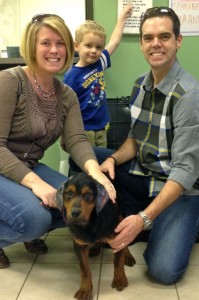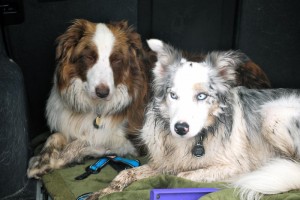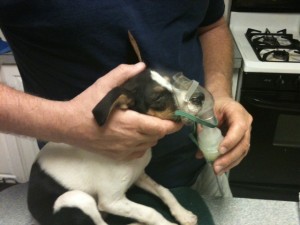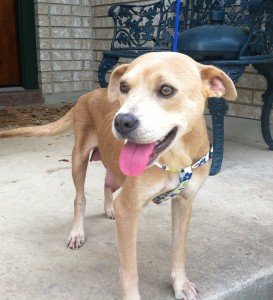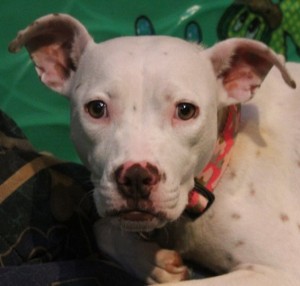Based on our anecdotal information, here is what we generally believe is, and is not possible with the NDV treatments for canine distemper.
NDV-induced serum
May save a dog or puppy of any age, but has to be used within 6 days of onset of symptoms. (Before going neuro.) A 90 percent survival rate is possible.
NDV as an IV injection
Might save a dog or puppy IF the immune system is intact, IF it is older than 12 weeks, and IF it is not a pure breed known to not have a response to NDV. This should not be the primary way to treat dogs, but might be used if the NDV-induced serum is not available.
Neither of these can help the nervous system, so when a dog gets to the neural stage there’s the …
NDV spinal tap
Has a nearly 50 percent survival rate. A professor at Kansas State who studied this treatment is not convinced that it helps. However, it may be that if given enough time and care many of these dogs can achieve a decent quality of life. Long term neurologic problems may remain, but may also be managed with drugs and physical therapy and other options.
But remember, even in the best of circumstances, distemper doesn’t play fair.
Here’s the rest of our FAQ …
Will these treatments save my dog from distemper?
It depends on whether your dog can be treated fast enough. Dr. Sears recommends that a dog be treated within six days of seeing symptoms. Unfortunately, many dog owners do not find out about this treatment until it is nearly too late. And often if the treatment is delayed too long other opportunistic diseases can set in. By then, even if the distemper symptoms are reversed, the dog could still die of the other diseases. In medical science there are no absolute guarantees, but if a dog is treated quickly and properly with Dr. Sears’ protocols, we believe there is an excellent chance of recovery.
How do these treatments work?
We don’t know the full story, yet. But here’s a possible explanation: The treatments are based on the Newcastle Disease Vaccine (NDV). Newcastle Disease is something that infects chickens. The vaccine was designed to give chickens immunity from the disease, but in the dog something else entirely happens. The Newcastle Vaccine may create a response within the dog’s immune system. We believe this is a previously unknown material or group of interacting materials that is able to neutralize the invading virus. We don’t know how or why, but it works and it works quickly, often within 24 hours.
What are the symptoms of distemper?
Distemper is often seen in two stages. In the first pre-neurological stage – before neural problems such as tics, twitches, spasms, seizures and paralysis – you may see hardening of the pads of feet, dulling of the eyes, mucous in the nose, coughing and respiratory trouble. Distemper attacks every system of the dog, so the damage is happening everywhere and there are symptoms you may not see. It can attack the stomach and make your dog vomit. For a while it may not attack the nervous system, this is because of the blood-brain barrier. However, it will eventually attack the oligodendrocytes, which controls the production of myelin. With the destruction of the myelin sheath that protects the nerves, the neurological stage begins. The neurologic problems could be seen as chorea – a kind of involuntary twitching and shuddering – as well as a loss of balance, chewing gum seizures – which look like the dog is trying to chew a piece of gum – to a full-body shaking and convulsions. Since other diseases may mimic the symptoms of distemper, your first step should be to confirm that your dog has the disease. Your vet can take a blood test for you, but by the time you get the results back the dog may be too sick to help. We recommend you get the blood tested anyway, but then treat for distemper without waiting for the results. Then later if the test does come back positive for distemper, you know you have saved your dog. But Dr. Sears has come up with a faster test called the Brush Border Smear.
My vet prescribed antibiotics and fluids. Won’t this cure my dog of distemper?
Sadly, no. Antibiotics and fluids are supportive therapy. The prevailing wisdom in veterinary medicine is that there is no cure for canine distemper. The vet prescribed the antibiotics not as a way to fight the distemper, but to prevent other opportunistic diseases such as bacterial pneumonia from attacking the dog. This makes sense, though. Distemper knocks down the immune system, allowing these other diseases to attack. So, even with the NDV treatments, you should pursue aggressive treatment with antibiotics. However, antibiotics do nothing against the distemper virus itself. The fluids are another supportive strategy that can help, but this is still part of the traditional approach of trying to control the symptoms and waiting to see if the dog lives or dies. Most dogs die without the NDV treatment.
So, what kind of treatment will save my dog?
That depends on how old your dog is and what kind of symptoms you are seeing. If your dog is pre-neurological, your dog might be treated with Dr. Sears’ serum. Unfortunately, the serum may not be available or you may not have enough time for a vet to make the serum. In this case, if the dog is old enough — more than 12 weeks — and has a strong enough of an immune system, an injection of the NDV vaccine may save the dog. Some dogs recover that easily. But this is not as reliable as the serum, and you won’t know for sure that it will work until you try it. If the animal is too young a puppy or has a compromised immune system, you will need to use the serum. If the dog is neurological, then the treatment is an injection of the NDV vaccine into the spinal canal. This allows the treatment to attack the distemper virus that is destroying the nervous system.
How did Dr. Sears discover his serum?
Dr. Sears discovered the serum when he was a practicing veterinarian in Lancaster, California. After being overwhelmed with distemper cases, Dr. Sears tried a variety of possible treatments, but none worked. Then, he read an article in the Journal of the American Animal Hospital Association of a study that showed Newcastle Disease virus could boost levels of Interferon in cats. [Here is an example of an article on the NDV studies in cats. Click for PDF ] He thought it worth it to try the same procedure in dogs, but made a mistake and did not withdraw the blood serum at the same time as reported in the article. With the change in timing, the serum he created did not have Interferon. Tests from Cornell University confirmed that his sample did not contain Interferon. However, before he got that result back, he had already treated a distemper dog with the serum and it completely recovered. Obviously, some other new material or combination of materials had saved the dog’s life. But Dr. Sears does not know what that material is.
What is Dr Sears’ serum?
The serum is created by using a donor dog, which is injected with the NDV vaccine. The donor dog’s immune system is triggered to create a disease-fighting material, which is still unidentified. But at a crucial time, blood is drawn from the donor. The serum is separated from this blood and then can be used to save a dog in the pre-neurological stage. The NDV-induced serum does not include the NDV virus. If used within the first six days of symptoms, the serum can stop a dog from ever having seizures.
Is the donor dog hurt?
No. When done properly in a veterinary clinic and monitored by a vet, the creation of the serum does not hurt the donor dog.
Can I use this to treat my dog without a vet?
No. These protocols are meant to be used by vets treating their sick patients. You should not be treating an animal on your own and without veterinary guidance. If your vet is not interested in using these treatments, contact us and we can make a referral to a vet who is.
But why doesn’t every vet use this treatment?
Because this is not taught in veterinary schools, and it is not yet published in a veterinary journal. It has not yet been accepted by the veterinary community. But that doesn’t mean it is not valid. We believe this is a previously unknown ally in our battle against disease. And it was discovered by accident, by a simple veterinarian in a California desert community, not at a major research facility or university. In the 1970s, Dr. Sears tried to present his discovery to a veterinary conference in Las Vegas, but he was told to “sit down, that’s impossible.” So, he sat down and then spent years quietly saving hundreds of dogs from this disease. His work drew no attention until it was published on a Web site in 2000, and it has only been in the past couple of years since his retirement that other vets have quietly picked up his work. We understand the reluctance of vets to try these treatments. They have not yet been proven or published yet. But we are gathering statistics on their effectiveness. It will be a long road before these treatments attain publication and acceptance. But we are working toward that goal. We have faith that this will happen eventually.
But this is so wonderful. It’s a miracle cure, isn’t it?
Whoa. Don’t get ahead of yourself. If the dog is treated within six days, there is an excellent chance of recovery. But so many people find out about these treatments late. This is not a resurrection technique. It cannot save a dog who has been on the brink of death for weeks and return them to health. And with the spinal tap treatment for the neurologic distemper, you must remember that the seizures usually do not go away immediately. Sometimes it takes days, weeks, months. But remember, there is always the danger of pneumonia and other diseases that can kill your dog. Also, please realize that every dog will react to this differently, just as they react to distemper differently. Factors that can affect the outcome include age, the strength of the immune system, neutering, loss of T-cell function and the genetics of the virus and of the vaccine. Even under the best of cases there will be those who do NOT respond. We aren’t promoting a miracle, but we can offer hope for distemper dogs.
What happens if I don’t get my dog treated within six days?
Then you are likely to see the neurologic phase begin. There still is hope for your dog, but the odds of success start to drop. Dr. Sears says that when he was in practice, the survival rate of dogs treated with the serum within six days of symptoms was in the high 90s. But so many dogs do not get treated in time and go into the neurologic phase, and the serum cannot help neurologic symptoms. The spinal tap might help, but the survival rate for dogs treated with the NDV spinal tap is about 50 percent. The longer you wait, the more the odds of survival drop. And a professor at Kansas State who studied the NDV does not believe it is beneficial. However, many dogs who reach neuro stage of distemper have a chance to achieve a reasonable quality of life even with good enough nursing care.
And who are you?
We are Save Dogs From Canine Distemper, a project run by Kind Hearts in Action, a nonprofit based in Los Angeles to rescue and find homes for stray dogs. The project director for Save Dogs From Canine Distemper is Ed Bond, whose dog, Galen, was saved by Dr. Sears in 1997. When Galen’s story was first published on the Internet in 2000, Dr. Sears finally posted the protocol for his NDV-induced serum.
How do I order the serum?
The serum cannot be mailed or shipped within the U.S., but vets can make the serum in their clinics, store it there and treat dogs brought to them. We do not sell any veterinary product ourselves. And it is up to the vet clinics themselves to decide how to reach out to the public.
What other diseases in dogs does the serum treat?
According to Dr. Sears, it has also cured dogs of herpes. It may have a beneficial effect on dogs with canine influenza. However, that depends on what strain of the virus that is attacking. However, we know for certain the serum and the NDV treatments do NOT cure parvo.
Tell me more about Dr. Sears
Dr. Al Sears was born in the Canal Zone of Panama. He went to the University of Pennsylvania and the University of California at Davis and spent 40 years practicing small animal medicine in Lancaster, Calif. He retired in 2006. More information: http://alsears.wordpress.com/
So, who is Ed Bond?
Ed Bond is the project director on canine distemper for Kind Hearts In Action, a 501c3 charity in the U.S. He also runs a group of websites on behalf of Dr. Sears. He became involved in this issue after his dog was saved from distemper by Dr. Sears in 1997. He has been an activist for this cause since December 2008, when he started the Save Dogs From Canine Distemper cause on Facebook. He now manages information about Dr. Sears and his treatments on Facebook, WordPress, Twitter and YouTube, as well as a discussion board on neurologic distemper. However, he is not — and does not claim to be — a vet, a scientist, a researcher or an expert. He is a former journalist, using the tools of media and the Web to spread the story about Dr. Sears and his treatments, as well as documenting the outcome of as many distemper cases as possible. Ed Bond can answer many questions about the NDV treatments as Dr. Sears has explained them to him, and most of the information needed to use the treatments are on these websites, which are reviewed and approved by Dr. Sears. However, when questions become too technical, Ed will refer you directly to Dr. Sears or to another vet. More about Ed Bond.



